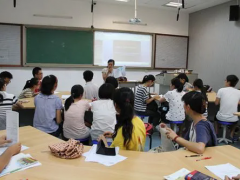小学英语英语说课稿范文英文版
小学英语全英文说课稿
Good morning, everyone! Today, Ill say something about Unit 9 Part A in Book 4 of Oxford English. Background on the reformation of curriculum, this book can connect the life and act, emphasize the interest and experience of the Ss, the pictures are active and vivid. Grade four is the initial stage of English learning, so it stresses on the emotion of the Ss, creates a well beginning for the Ss. This Unit has 7 parts, well learn Part A mainly, it embodies the repeating characterize. Review the learned language points “Wheres…”and the new language points will be represented in the following units. So this unit forms connecting links with a special meaning in this book. The content of this period is to use “Wheresare…” to determine the place. And according to the contents and the fact of the Ss, I establish the following three teaching aims of this period: The first one: students can listen, read, say and spell the following words: a glass, a fridge, an egg, bread and a table. The second one: students can listen, read, say and write the following daily expressions: Whats for breakfast? Have some juice then. The third one: students can listen, read, say and write the following sentence patterns: WheresWhere are themy… Its Theyre… Theres no …in on near… I think the most difficult point of this period is to make sure the students can use the patterns “WheresWhere are…and There is no …inonnear…” in their daily life correctly. And I will use some pictures, words and sentence cards, a tape recorder and the multi-media computer to help me achieve the aims. The task-based method, communicated method, group cooperate method will be used in this period. To accomplish the aims, I design the following steps: Step 1 Songs and the game arousers the emotion. In order to attract the Ss attention and construct an atmosphere of learning English, I let the students sing some English songs and play the game “Simon says”. At the same time the game can review the prep, serve the knowledge as foil and consist the appearance of the knowledge. Step 2 Change class to life, happy to say. The substance of language is communication and the environment of communication is life. So when I present the sentence pattern “Whats for breakfast?” I first show a clock to elicit the time for breakfast, teach the sentence. Then show my own photo of having breakfast, Ss ask and guess. In this way I can attract Ss attention, encourage Ss to ask Qs with the new knowledge. Most of the Ss have learnt the sentence pattern: Wheres…? so I design a task for Ss to help Helen find the food and drinks for breakfast, and teach the new language points: Where are…? Theyre … Meanwhile stick the sentences on the Bb. After some practice by asking and answering, I present the next language points: Theres no …inonnear… Have …then. And I will stick these sentence patterns on the Bb. Finally Ill let the Ss do pair works to consolidate them. Step 3 Listen to the tape and Ss imitate to read and say. As the new reformation of curriculum, emphasized the traditional class attach importance to the mechanical teaching, neglect the experience and participation, for example, the five-step method. So in this lesson, after presentation, I ask Ss to listen to the tape with three Qs, read in different roles and in pairs, then try to recite the text. Step 4 Ss be the main body, T makes a guider. In class, Ss play as a host, and the T makes an influence on guiding, help Ss to act the learnt dialogue, it can stress the position of the Ss, and arouse their interest. Then I show a carton with no voice, ask Ss to make a dialogue in pairs. There are lots of ways to consolidate the new knowledge. Playing game is a good way. So according to the physiology of Ss, I hold a group competition during the game, ask Ss to finish the blanks. In this way can develop Ss good habits and achieve the aim of mastering the learned knowledge in situation. Step 5 Change class to life, learn by themselves. Is this the end of the class? I dont think so. If there is an end, I think it should be in the life. So I extend this class, encourage Ss to use the learned to communicate with each other in their life. In a word, the whole period is based on tasks, which are designed from easy steps to steps that are challenging. When the Ss are carting out the tasks, they can acquire information, knowledge, and have their ability and skills trained. Thats all. Thanks a lot for your attention.。
求小学英语纯英文的"说课稿"我们被要求说5分钟的春英语的英语说
一、说教材 1.教材简析。
本课共有两部分内容,其中第一部分是以中秋节为话题而展开的一个对话。它主要讲了Han Mei和Lucy简单谈论有关中秋节和月饼方面的知识,并邀请Lucy到她家作客的过程。
在这个对话中出现了如autumn和festival等十一个新单词以及几个学生难以理解的、需教师解释的词、句型和句子。 第二部分内容是两人在商店为朋友买月饼的一个情境,谈话内容是从月饼表面的样子的好坏、大小、轻重和价钱等方面展开的。
其中出现了形容词比较级的用法,它们是:nicer, bigger, heavier, cheaper。它要求学生根据图、词和句子提示创造性的对话。
2.教学重点。 (1)指导学生掌握和熟练运用那些难以理解的词、句型和句子,如cakes with meet。
(2)指导学生口头熟练表达就中秋节这一话题展开的对话内容,包括第二部分的购物经过。 (3)形容词比较级的用法。
3.教学难点。 学生根据实际情境需要真正开口讲英语。
4.教学目标。 (1)技能目标。
学生能听懂本对话录音,能听懂师生之间就本对话内容而展开的、切形式的问答,会和别人展开对话,了解和传递信息;能就本课语言难点造句,而且无语法错误;能就类似话题,创造性地自编对话;掌握形容词比较级的用法。 (2)知识目标。
学生要牢记所有新学单词,包括重点字母或字母组合的发音,还要记住新学短语、句型、难句及本对话各句的英语表达,为实现自如讲英语奠定基础。 (3)情感目标。
学生要爱学英语、爱说英语、想说英语,对英语学习投以极大的兴趣和热情。 (4)学习策略目标。
改变传统的死记硬背,积极主动地投入到语言的实践中去,包括听、说、读、写的实践。在实践中提高语言的综合使用能力,加深对基础知识的掌握和记忆。
(5)文化意识目标。使学生进一步了解和会简单向别人介绍中国这个传统节日,从而体会节日的快乐。
二、说教法 对本课我主要采取了如下几种教法: 1.听录音。 听音是英语学习的重要方法,也是课堂教学的重要步骤。
在听中可以感知,可以模仿。 2.重点解释,个别操练。
在每一堂教学中,学生总会遇到一些难以理解的词、句型、短语、句子或某一语法现象。 如本课出现的形容词比较级的用法等都需要教师个别解释甚至创设语言情境进行操练和举例,以扫除自由交际过程中的“拦路虎”,为语言的进一步学习奠定基础。
3.指导学生展开情景对话。 教师可以和任何一个学生对话。
开始时和学习好的可多说几句,和学习差的可以少说几句,要想办法使人人开口,使人人都有成功感。 通过对话逐步达到对教材内容的全部操练。
在对话时可不受课文内容和顺序的限制,师生完全可以根据当时的实际思路创造性地交流,这种教法是实现语言知识向语言能力转变的必经之路。师生对话时,其他学生静听。
4.学生独立操作。 首先要求学生根据师生示范独立对话,随后叫几组分别站起来表演。
这是深化课堂教学的重要举措。 5.教师可设计填空或翻译练习,以检查学生对本对话的掌握情况。
在整个教学活动中,我还采用了投影仪、挂图、卡片、实物等,对顺利开展教学活动起到了很好的辅助作用。 三、说学法 我所采用的教法有助于学生掌握如下学法: 1.养成听的习惯。
学生要经常听录音,听教师讲英语,听同学们讲英语,这对学好英语大有好处。 2.科学储备大量知识。
学生不掌握丰富的知识就不可能进行很好的语言交流。所以学生必须了解语言规律,掌握丰富的词汇,熟知语法规则,会熟练表达由各个话题而展开的交际内容。
要学会在实践中学,在应用中学,这样学来的知识记忆深刻、灵活度大。 3.及时巩固,反复记忆。
凡教师在课堂上所讲到的语言难点,学生应及时整理,再次认识并积极使用。对前面已学过的课文,学生要有安排地经常复习,否则常常是学了新的,忘了旧的。
4.积极操练,重在口头。 在课堂上,学生要积极参与教师设计的每个教学活动,要大胆开口,创造性地说自己想说的话。
课后和其他同学及时进行英语交流。只有这样,才能将书本知识变成自己的知识和语言能力;也只有这样,才能实现脱口说英语的目的。
四、说教学程序 1.复旧引新阶段。 教师和学生进行简单的问候,如: Ss: Good morning, teacher! T: Good morning, class! 之后,就上单元的话题和学生展开对话: T: Comrades! We wont have any lessons this afternoon。
Im going on a field trip。 Would you like to go with me? Ss: Yes, we do。
T: Where are we going? Ss: Were going to the mountains /rivers / hills。 。
。 T: What do you think were going to do? Ss: Were going to have a picnic /discuss the air outside。
教师可根据当时的情况和学生继续多谈几句,交谈的思维要顺着学生的思维展开。 之后,老师问道: T: Do you know what day is tomorrow? Ss: Yes, we do。
/No,we dont。 T: Now let me tell you。
Tomorrow is Mid-autumn Festival。 Were going to have a big dinner。
Would you like to come to my home to eat something? Ss: Yes, wed love to。 到此引出新学课文,教师说:Now lets learn Lesson9。
之后板书“Lesson9”。 2.熟悉语言阶段。
(1) 学生看着书听一遍。
人教版英语说课稿,英文版的!
Unit2 Healthy eating说课稿 Period1: new Words &warming up Teaching procedures: Step1: New words study Step 2.Warming up 1)Show Ss some pictures of food and ask Ss to tell the names 2) Do you know the food you eat helps you grow in different way? Do the warming up on p 9 Step 3 Speaking 1)Which one would you prefer? Western food or Chinese food?Why? 2)What do you usually have for breakfast / lunch /supper ?(group work, Ss ask and answer and collect information) Discussion What is healthy diet? Healthy diet: a diet that is balanced and neither too rich in fat, sugar and salt nor too poor and lacking in essential nutrients. Step4:Summary and homework. HW: Preview the reading(Tor F on P 11) EWVol.29 Topic reading Period2 Reading Step 1: Pre- reading Look at the title of the reading passage and the pictures. Predict what the passage is about. Step2:Fast reading Read the text quickly to find out which sentence is the main idea of the text.A .The two restaurants supplied the healthy food. B. The reason why Yong Huis restaurant was so popular with customers. C. Wang Pengwei found out why he had lost his customer and decided to win them back. [C] Step3: Second reading: 1) Compare the two restaurants: WangPengs restaurant Yong Huis restaurant Food drink price strength of the diet weakness of the diet 2) Divide the whole passage into three parts, and give the general idea of each part and then retell the story. Para1: Wang Peng is worried because his restaurant is not as full as usually is. Para2: He follows his friend to a newly opened restaurant which is very popular. Para3: Worried, he does some research to win his customers back. Step4: Post-reading Do Ex1 and Ex3 on P11 Step 5 : Summary and homework 1.Preview the reading II on P 14-15 2.P12Exx1-3 3.EW Vol. 29 Reading task Period 3 Reading II Step 1 : Revision Revise the reading I Step 2: Prediction Can you guess what will happen to Wang Pengwei and Yong Hui? Step 3: Reading Do the Ex1 on p15 Step 4 Discussion What can we learn from the passage? We can learn that it is never too late to change bad eating habits and begin afresh. Step 5 : Sum up the whole story. Step 6: Homework: 1. Retell the story in your own words. 2.学习两篇阅读的重点单词用法(EW Vol. 29第二版) Periods 4-5 Language points: Reading I 1. diet 2. balance 3.curiosity4. raw5. strength 6 be tired of 7. win… back8. consult sentences: 1.Nothing could have been better 2 He couldnt have Yong Hui getting away with telling people lies! Reading 2 1. earn ones living 2 in debt 3.glare 4spy on 5. limit 6. benefit 7. combine 8. before long 9. cut down 10 put on HW: EW Vol. 29 checking corner Part 1 Period 6 Grammar 情态动词2 1. ought to/should should 和ought to 都为“应该”的意思,可用于各种人称。
ought to 的语气稍重一些。 You ought to (should) follow your teachers advice. 表示主语的义务或责任: You should take care of your sister. 你应当去照顾你妹妹。
或指出—个正确、明智的动作: They shouldnt allow parking here;the street is too narrow. 这儿不该允许停车;马路太窄了。 should 和ought to 后面跟动词不定式的完成式,其肯定句表示”过去应该做而未做”, 其否定句则表示”过去不该做但做了”。
You should/ought to have made the decision a week ago. I shouldnt have made such a foolish mistake. 多数情况下,ought to 可与should互换使用。ought to的反意疑问句用shouldnt替代。
2. must和have to must的用法 1)表示主观的义务和必要, 主要用于肯定句和疑问句, 意思为 “必须……,得……,要……”;由must 引起的疑问句,肯定回答要用must或have to, 否定回答要用neednt或dont have to, 意思是“不必” ; must的否定形式mustnt表示禁止,意思是“不能,不许”。如: — Must I finish the task right now? 我现在必须完成这个工作吗? —Yes, you must. / Yes, you have to. 是的。
(—No, you neednt. / No, you dont have to. 不,不必。) You mustnt come here without permission. 未经允许,你不能来这儿。
have to 的用法 1)must表示一种主观的需要,而have to 表示一种客观的需要,意思是“不得不”。 如: I have to attend an important meeting this afternoon. 今天下午我不得不参加一个重要的会议。
Mother is out, so I have to look after the shop. 妈妈不在家,因此我不得不照看商店。 2)have to 的否定形式是dont have to, 相当于neednt。
如: They dont have to buy a computer at present. 他们目前没有必要买电脑。 Period7 Listening (P48)and exercise checking Period8 Reading task(p52) and writing Writing 资料 基础写作练习: 洋快餐在中国深受欢迎,尤其是青少年及儿童的喜欢,但洋快餐是不是真的有益呢?。
小学英语全英文说课稿
我只知道小学应该这么讲先说Class begins,good morning/afternoon boys and girls.再说Do you know xxx?Its xxx(adj).Open your book and turn to page xxx,today well learn something about it/them.然后开始讲课就行了讲课中常用的:Practice in pairs(两人一组练对话)Open your bookClose your bookDo you have any questions?Look at blackboard.Write down some notes(做笔记)Stand up please.Ok,sit down.Listen to me.Letsplay a gameWho wants to have a try?(谁想试一试)最后Now class is over,see you next time.Thank you。
.。
牛津小学英语说课稿 英文版!!!!!!急得很~~~~~~
我只有小学的,希望能帮到你 牛津版小学英语4A第9单元 说课稿 Good morning, everyone! Today, Ill say something about Unit 9 Part A in Book 4 of Oxford English. Background on the reformation of curriculum, this book can connect the life and act, emphasize the interest and experience of the Ss, the pictures are active and vivid. Grade four is the initial stage of English learning, so it stresses on the emotion of the Ss, creates a well beginning for the Ss. This Unit has 7 parts, well learn Part A mainly, it embodies the repeating characterize. Review the learned language points “Wheres…”and the new language points will be represented in the following units. So this unit forms connecting links with a special meaning in this book. The content of this period is to use “Wheresare…” to determine the place. And according to the contents and the fact of the Ss, I establish the following three teaching aims of this period: The first one: students can listen, read, say and spell the following words: a glass, a fridge, an egg, bread and a table. The second one: students can listen, read, say and write the following daily expressions: Whats for breakfast? Have some juice then. The third one: students can listen, read, say and write the following sentence patterns: WheresWhere are themy… Its Theyre… Theres no …in on near… I think the most difficult point of this period is to make sure the students can use the patterns “WheresWhere are…and There is no …inonnear…” in their daily life correctly. And I will use some pictures, words and sentence cards, a tape recorder and the multi-media computer to help me achieve the aims. The task-based method, communicated method, group cooperate method will be used in this period. To accomplish the aims, I design the following steps: Step 1 Songs and the game arousers the emotion. In order to attract the Ss attention and construct an atmosphere of learning English, I let the students sing some English songs and play the game “Simon says”. At the same time the game can review the prep, serve the knowledge as foil and consist the appearance of the knowledge. Step 2 Change class to life, happy to say. The substance of language is communication and the environment of communication is life. So when I present the sentence pattern “Whats for breakfast?” I first show a clock to elicit the time for breakfast, teach the sentence. Then show my own photo of having breakfast, Ss ask and guess. In this way I can attract Ss attention, encourage Ss to ask Qs with the new knowledge. Most of the Ss have learnt the sentence pattern: Wheres…? so I design a task for Ss to help Helen find the food and drinks for breakfast, and teach the new language points: Where are…? Theyre … Meanwhile stick the sentences on the Bb. After some practice by asking and answering, I present the next language points: Theres no …inonnear… Have …then. And I will stick these sentence patterns on the Bb. Finally Ill let the Ss do pair works to consolidate them. Step 3 Listen to the tape and Ss imitate to read and say. As the new reformation of curriculum, emphasized the traditional class attach importance to the mechanical teaching, neglect the experience and participation, for example, the five-step method. So in this lesson, after presentation, I ask Ss to listen to the tape with three Qs, read in different roles and in pairs, then try to recite the text. Step 4 Ss be the main body, T makes a guider. In class, Ss play as a host, and the T makes an influence on guiding, help Ss to act the learnt dialogue, it can stress the position of the Ss, and arouse their interest. Then I show a carton with no voice, ask Ss to make a dialogue in pairs. There are lots of ways to consolidate the new knowledge. Playing game is a good way. So according to the physiology of Ss, I hold a group competition during the game, ask Ss to finish the blanks. In this way can develop Ss good habits and achieve the aim of mastering the learned knowledge in situation. Step 5 Change class to life, learn by themselves. Is this the end of the class? I dont think so. If there is an end, I think it should be in the life. So I extend this class, encourage Ss to use the learned to communicate with each other in their life. In a word, the whole period is based on tasks, which are designed from easy steps to steps that are challenging. When the Ss are carting out the tasks, they can acquire information, knowledge, and have their ability and skills trained. Thats all. Thanks a lot for your attention。
人教版小学英语说课稿包括哪些部分?人教版小学英语说课稿包括哪些
小学英语第四册 lesson 19 说课稿一、教材分析老师们,大家好。
今天我说课的内容是冀教版小学英语第四册19 课。本课主要讨论的是服装。
在三年级,学生对此话题已有一定的了解。因此,我根据学生的实际情况,结合本课新词 jeans 和句型What are you wearing ? Im wearing 。
的基础上,又拓展了一个新词sandals 和两个句型 Whats she /he wearing ?She/He is wearing 。本课内容难度不太大,并且十分贴近学生生活实际,有利于学生兴趣的激发和积极性的调动。
二、教学目标《英语课程标准》提出:激发和培养学生学习英语的兴趣,使学生树立自信心,养成良好的学习习惯,形成有效的学习策略,发展学生的自学能力和合作精神,是小学英语教学的基本任务。 在认真分析教材的基础上,我针对学生实际,将本课的教学目标确定如下:1、知识目标:⑴使学生能听说读jeans sandals等服装类单词。
⑵能够运用What are you wearing ? Im wearing 。 Whats she/he wearing ? She /He is wearing 。
来谈论穿着情况。2、技能目标通过引导学生积极参与各项课堂活动,使学生养成动脑、动口的好习惯,指导学生熟练应用本课所学的语言知识进行日常交际,形成综合运用语言的能力。
3、情感态度目标⑴培养学生仔细观察、认真模仿的良好习惯和主动竞争的意识。⑵激发学生学习英语的兴趣,使学生树立学习英语的自信心。
⑶培养学生学会思考,学会倾听,学会讨论,学会表达和评价的能力,培养学生的团结协作精神。三、教学重点、难点培养学生在特定的语境内领悟和使用语言交际的能力是小学英语教学的重点、难点。
新词jeans、sandals和三个句型What are you wearing? Im wearing 。 What is she/he wearing? She/He is wearing 。
是本课的重点;本课难点是正确选择运用服装类单词和句型以及培养学生学会思考、倾听和合作学习的能力。四、教法学法为了完成以上教学目标,更好地突出重点、突破难点,按照学生的认知规律和教材特点,我设计了以下教学方法:1、主体参与法:通过大量的4人小组操练、合作,给学生更多动口、动脑的机会,体现主体性和合作精神。
2、活动教学法:组织唱、猜、演等多种形式的活动,让学生在活动中学,在活动中用,发展学生的语言运用能力。3、创设情景法:结合学生生活实际,创设运用语言的情景,使学生在语言情感中感知、理解英语的含义。
五、教具准备牛仔裤、凉鞋等服装;布娃娃;录音机;服装图片小奖品;小黑板等。 六、教学程序教学目标的确立,教法学法的设计,最终要在教学程序中体现。
因此,合理安排教学程序是教学成功的关键之一。结合学生的认知状况,我用6 个环节来完成本课的教学。
1、组织教学本着小学生爱唱爱跳的年龄特征,在一上课进行简单的师生问候后,便带领学生一起听、唱英语歌。 Where is Jenny? 选择这首歌曲的原因有两个:一是歌曲简单,节奏明快,易于调动学生情绪;二是新词旧调,为下一环节创编歌曲做准备。
2、复习旧知,服务于新知。在复习服装类单词这一环节,本着短时高效的原则,我设计了小组课前搜集—课上反馈—解疑答问—集体认读---个人内化几个任务。
这一阶段任务的完成,真正把学习的主动权还给学生,让他成为自己学习的主人。培养了学生积极反应、主动参与和竞争意识。
3、学习新知。新知识的教学分以下两部分:⑴单词教学在单词教学中,我运用实物形象展示,引出新词,给学生以深刻的第一印象。
游戏所带来的乐趣会使每一位参与者保持一种积极的心态。 因此,在操练时,我首先进行了一些模仿跟读等机械性练习,本着词不离句的原则,又设计了一个游戏Touch and Guess,练习句型This is These are 。
学生在游戏的过程中既是组织者,又是参与者,还是评价者,轻松愉快地掌握了知识,得到了锻炼。 ⑵句型教学游戏结束后,我引导学生仔细观察老师的穿着,使学生轻松自然地过渡到句型的学习与应用。
句型What is she wearing ? She is wearing 。 是由一个可爱的穿着绿色连衣裙的布娃娃来呈现的。
学生在亲切、友好的氛围中和布娃娃握手、问好,用英语交流,完全沉浸在认识新朋友的喜悦之中。 4、操练巩固语言的内化必须通过大量语言实践活动。
因此,在句型操练环节,我采用机械性与趣味性相结合的方式。机械性操练主要有:listen and follow ;look and listen ; read by yourself ;listen and answer 。
学生通过这样机械性操练可以更加熟练的掌握语言,并为顺利完成下一环节做充分的准备。趣味性操练有:连锁问答;创编歌曲。
使学生在轻松、愉悦、充满自信与成功的氛围中不仅学会了语言知识,还培养了创新能力,实现了英语与音乐学科的整合。5、运用拓展学习语言的目的就是为了运用语言。
在这一环节中,我设计了两个小组合作任务:一是look and guess, whos she/he ?教师通过小黑板出示相关的语言材料。小组成员在思考-- 观察-- 讨论-- 总结 -- 汇报的过程中,运用老师提供的语言材料,将新旧知识进行融合、重组,齐心协力,共同完成任务。
既增强了趣味性,又培养了学生的团结合作精神。二是情景会话。
小组成员可以选择教。






